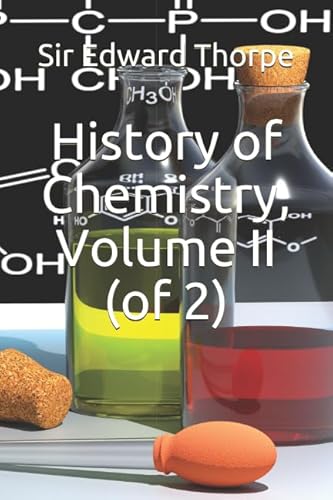Items related to History of Chemistry, Volume II (of 2)

In the preceding volume an attempt was made to outline the significant features in the development of chemistry, as an art and as a science, from the earliest times down to about the middle of the last century. Since that time chemistry has progressed at a rate and to an extent unparalleled at any period of its history. Not only have the number and variety of chemical products—inorganic and organic—been enormously increased, but the study of their modes of origin, properties, and relations has greatly extended our means of gaining an insight into the internal structure and constitution of bodies. This extraordinary development has carried the science beyond the limits of its own special field of inquiry, and has influenced every department of natural knowledge. Concurrently there has been a no less striking extension of its applications to the prosperity and material welfare of mankind. With the death of Davy the era of brilliant discovery in chemistry, wrote Edward Turner, appeared for the moment to have terminated. Although the number of workers in the science steadily increased, the output of chemical literature in England actually diminished for some years; and, as regards inorganic chemistry, few first-rate discoveries were made during the two decades prior to 1850. Chemists seemed to be of Turner’s opinion that the time had arrived for reviewing their stock of information, and for submitting the principal facts and fundamental doctrines to the severest scrutiny. Their activity was employed not so much in searching for new compounds or new elements as in examining those already discovered. The foundations of the atomic theory were being securely laid. The ratios in which the elements of known compounds are united were being more exactly ascertained. The efforts of workers, Graham excepted, seemed to be spent more on points of detail, on the filling-in of little gaps in the chemical structure, as it then existed, than in attempts at new developments. For a time—during the early ’thirties—chemists struggled with the claims of rival methods of notation, and it was only gradually that the system of Berzelius gained general acceptance. At none of the British universities was there anything in the nature of practical tuition in chemistry. Thomson, at Glasgow, occasionally permitted a student to work under him, but no systematic instruction was ever attempted. The first impulses came from Graham in 1837, when he took charge of the chemical teaching at the University of London, and when, in 1841, he assisted to create the Chemical Society of London. Four years later the Royal College of Chemistry in London was founded and placed under the direction of August Wilhelm Hofmann—one of the most distinguished pupils of Liebig. Under his inspiration the study of practical chemistry made extraordinary progress, and discovery succeeded discovery in rapid succession. In bringing Hofmann to England we had, in fact, imported something of the spirit and power of his master, Liebig. Among the pupils and co-workers of Hofmann were Warren de la Rue, Abel, Nicholson, Mansfield, Medlock, Crookes, Church, Griess, Martius, Sell, Divers, and Perkin. Whilst at Giessen he had begun the study of the organic bases in coal-tar with a view more especially of establishing the identity of Fritzsche’s anilin with the benzidam of Zinin and the krystallin of Unverdorben. Hofmann continued to cultivate with unremitting zeal the field thus entered. With Muspratt he discovered paratoluidine and nitraniline; with Cahours allyl alcohol. His pupil Mansfield worked out, at the cost of his life, the methods for the technical extraction of benzene and toluene from coal-tar, and thereby made the coal-tar colour-industry possible.
"synopsis" may belong to another edition of this title.
- PublisherIndependently published
- Publication date2017
- ISBN 10 1549868659
- ISBN 13 9781549868658
- BindingPaperback
- Number of pages124
Buy New
Learn more about this copy
£ 11.21
Shipping:
£ 10
From United Kingdom to U.S.A.
Top Search Results from the AbeBooks Marketplace
History of Chemistry, Volume II (of 2)
Published by
Independently published
(2017)
ISBN 10: 1549868659
ISBN 13: 9781549868658
New
Paperback
Quantity: 1
Seller:
Rating
Book Description Paperback. Condition: Brand New. 124 pages. 9.00x6.00x0.31 inches. In Stock. Seller Inventory # zk1549868659
Buy New
£ 11.21
Convert currency

